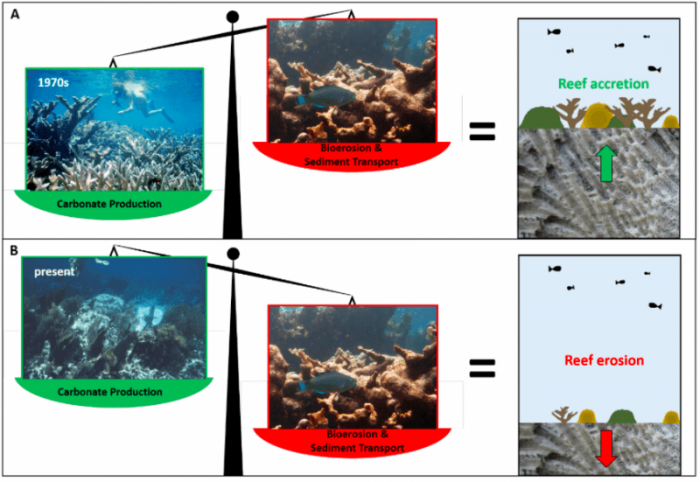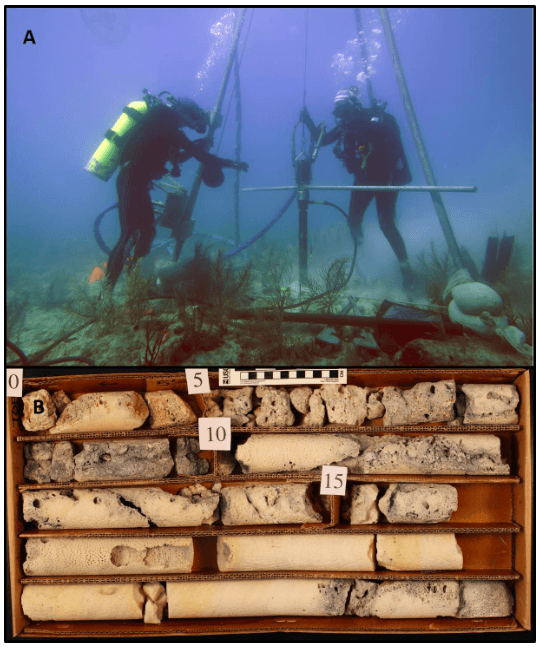
Florida’s reefs are now at risk of eroding away
Over the last 50 years, coral bleaching, disease, and other human disturbances have caused declines in coral populations that are without precedent in the history of coral-reef science. The ecological degradation of coral-reef ecosystems around the world has now reached a point where further declines are threatening the persistence of the complex geological structures built by corals over thousands of years.
Importantly, these structures provide the foundation for all the benefits reefs provide to society, including habitat that supports fisheries, marine biodiversity, and the reduction of wave energy reaching reef-lined coasts.
The growth of coral reefs, or “reef accretion,” is controlled by the balance between the growth and abundance of corals and other organisms that form carbonate skeletons — collectively referred to as “carbonate production” — and the subtractive process of reef erosion by carbonate-consuming organisms like parrotfish (“bioerosion”) and sediment transport (Fig. 1). Recently, coral mortality has caused declines in reef accretion on a global scale and many reefs are now beginning to erode away.

Figure 1. The balance between carbonate production and bioerosion, which, together, determine whether the process of reef accretion or reef erosion is dominant. When the additive processes of coral growth and the growth of other calcifying organisms (carbonate production) outweighs the negative impacts of erosive processes, then reef accretion is favored and new reef structure is built (A). In recent decades, as coral populations have declined, studies suggest that this balance has been tipped to favor reef erosion (B). The photographs used to illustrate carbonate production in the 1970s and at present were taken by E.A. Shinn on Grecian Rocks Reef, off Key Largo, Florida in 1971 and 2001, respectively.
For most coral reefs, the decline in the geological process of reef growth was a consequence of modern coral loss, but a recent study (1) by scientists at the U.S. Geological Survey suggests that reef growth in south Florida stalled long before the modern coral-reef crisis. The study analyzed trends in reef accretion over the last 8,000 years based on radiocarbon dating of 46 coral-reef cores (Fig. 2) collected throughout the 350 km (~200 mi) Florida Keys reef tract.

Figure 2. (A) Shows L.T. Toth and student volunteer E.M. Whitcher collecting a coral-reef core from Western Sambo Reef, off Key West, Florida. Photo by A. Stathakopoulos. (B) Photograph of a coral-reef core collected from Pulaski Lighthouse in Dry Tortugas National Park.
Florida’s coral-reef ecosystem is unique because it is located in the subtropics where winter “cold snaps” periodically chill the waters to the point where corals can no longer survive. Coral reefs generally only grow where minimum temperatures are greater than 65°F. Winter water temperatures in Florida typically hover right around this threshold, but occasionally the water gets much colder, which can suppress coral growth and, therefore, reef accretion.
The study highlights the sensitivity of reef-building to climatic variability. During a period of relatively warm climate ~7,000 years ago, known as the “mid-Holocene climatic optimum,” Florida’s coral reefs grew apace with reefs elsewhere in the western Atlantic. As the climate cooled during the late Holocene, however, reef accretion declined rapidly (Fig. 3). By 3,000 years ago, reef-building had ceased throughout the majority of the reef tract, signaling the geological shutdown of Florida’s reefs.

Figure 3. Conceptual diagram of the history of coral-reef development in the Florida Keys. The graph shows average (black line; shaded area indicates ±95% confidence intervals) reef accretion across all sites in the Florida Keys. Reef accretion began to decline as climate cooled following the Holocene Thermal Maximum. By 3,000 years ago, reef accretion was negligible throughout the region, signaling the geological shutdown of Florida’s coral reefs. Although living coral populations persisted on Florida’s reefs after this time, in the last several decades anthropogenic warming and other disturbances have caused declines in coral cover and have pushed Florida’s reefs into a state in which erosion is now the dominant process (illustrated conceptually with the dashed arrow).
Florida’s reefs have grown little in the last 3,000 years, but existing ecological studies suggest that the decline in coral populations and the transition to reef erosion was a recent phenomenon. Apparently, the living veneer of coral that capped Florida’s reefs was, until recently, able to prevent the transition to reef erosion. Although climatic cooling suppressed reef accretion in south Florida in the past, most of the world’s reefs now have the opposite problem: it’s becoming too warm for corals to survive. Modern climate change and other anthropogenic disturbances have caused widespread coral mortality, removing that protective living-coral barrier and potentially pushing reefs past a tipping point at which the reef structures built over thousands of years are now at risk of rapidly eroding away (Fig. 3).
These findings are described in the article entitled A 3000-year lag between the ecological and geological shutdown of Florida’s coral reefs, recently published in the journal Global Change Biology. This work was conducted by Lauren T. Toth, Ilsa B. Kuffner, and Anastasios Stathakopoulos from the U.S. Geological Survey Coastal and Marine Science Center in St. Petersburg, FL, and Eugene A. Shinn from the University of South Florida’s College of Marine Science.









